Using the best portable water filter will dramatically improve your hiking and camping experience. First of all, once you start using a filter you won’t have to carry a lot of water with you at any given time.
You can simply use the filter to refill your water recipient as you go. Second, you will actually lower your travel expenses. Instead of buying water at the start of the trail at exorbitant prices, you can simply use the filter to make the water you encounter on your trip drinkable.
And the best thing is, the models we present in the following portable water purifier reviews can make almost every source of freshwater drinkable.
In the following article, we take a look at some of the top portable water filters you can use on the run and reveal their pros and cons.
Best Portable Water Filters Comparison Chart
| QUICK COMPARISON OF FEATURED PRODUCTS | |||
|---|---|---|---|
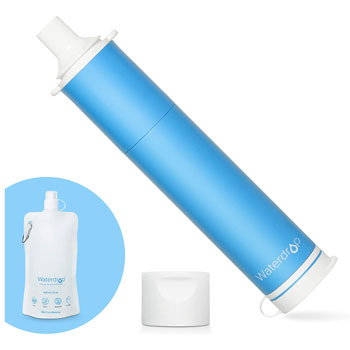 | Waterdrop Water Filter Straw | Use with water bags or connect to water bottles to filtrate water. | View on Amazon |
 | Sawyer Products Mini Water Filtration System | A single filter cartridge can clean up to 100,000 gallons of water without needing a replacement. | View on Amazon |
 | LifeStraw LSPHF017 Water Filter for Hiking, Camping | The filter will remove up to 99.9% of the bacteria and protozoa commonly found in water. | View on Amazon |
 | Katadyn Vario Water Filter | Thanks to its efficient filtering mediums, this model is capable of filtering up to 2 quarts of water per minute. | View on Amazon |
 | Sawyer Products PointOne Squeeze Water Filter System | This model can remove more than 99.9% of the bacteria and protozoa, so it will allow you to drink from any source of freshwater you discover. | View on Amazon |
 | LifeStraw Go Water Filter Bottle | This water filter removes any foul tastes and smells, and will also remove 99.99% of the bacteria and protozoa. | View on Amazon |
 | Survivor Filter PRO | This will remove 99.9% of the bacteria and viruses in the water, and up to 99.5% of the heavy metals. | View on Amazon |
Best Portable Water Filter Reviews – (Updated List)
1. Waterdrop Water Filter Straw
 Being able to have fresh water on the go, regardless of where you are, is invaluable. This Waterdrop filter is as portable as they come with its 8 inches of length. What we like the most about it is the levels of versatility. You can have it connected to almost any bottle or a bag. Furthermore, you can use a tube for connection in case the nozzle of a bottle isn’t of the proper size.
Being able to have fresh water on the go, regardless of where you are, is invaluable. This Waterdrop filter is as portable as they come with its 8 inches of length. What we like the most about it is the levels of versatility. You can have it connected to almost any bottle or a bag. Furthermore, you can use a tube for connection in case the nozzle of a bottle isn’t of the proper size.
The long-life is another thing that impresses here. You will be able to use the filter for about 100,000 gallons of water. Even if you spend a lot of time in the wilderness, you will struggle to deplete the filter.
Among the threats, this unit will eliminate we can list: E. Coli, Salmonella typhi, protozoans, vitriol cholerae, and others. You will have to refer to the instruction manual for the full list because we simply cannot fit in here.
Pros: the long life of the product is undoubtedly what will attract the most users. We can’t underestimate the effectiveness too.
Cons: you cannot and should not drink straight from the unit. It has to be attached to a water container.
2. Sawyer Products Mini Water Filtration System
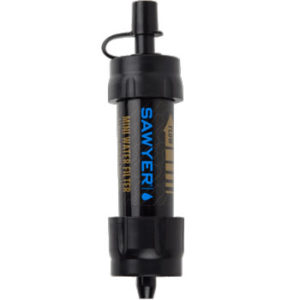 The Sawyer mini filtration system is a compact water filtering solution for those who enjoy camping, hiking and traveling. Even though it’s small, this water filter is extremely efficient and will remove up to 99.99% of the parasites, bacteria, and viruses in the water. The filter is also very durable. A single filter cartridge can clean up to 100,000 gallons of water without needing a replacement.
The Sawyer mini filtration system is a compact water filtering solution for those who enjoy camping, hiking and traveling. Even though it’s small, this water filter is extremely efficient and will remove up to 99.99% of the parasites, bacteria, and viruses in the water. The filter is also very durable. A single filter cartridge can clean up to 100,000 gallons of water without needing a replacement.
One of the things we liked about this model is that it comes with a great adapter. The adapter is small and versatile, and you can attach it to water bottles, water pouches, or even to faucets to improve the quality of your drinking water.
- Pros:
Very Easy To Use – This water filter is very easy to use, and it can be helpful when you’re trekking or camping in new locations - Cons:
Squeeze Bags Can Burst – The water filter comes with a squeeze bag that makes the water filtration easier. However, the squeeze bag can burst unexpectedly, so it would be better to pack a water bottle as well.
3. LifeStraw LSPHF017 Water Filter for Hiking, Camping
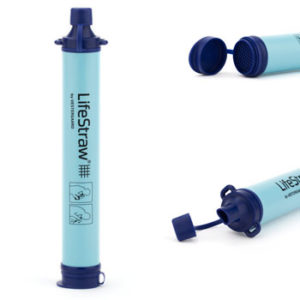 The LifeStraw personal water filter is probably the most popular model available on the market at this moment. This unit is small, extremely easy to use, and it comes at a great price, making it a public favorite.
The LifeStraw personal water filter is probably the most popular model available on the market at this moment. This unit is small, extremely easy to use, and it comes at a great price, making it a public favorite.
We were impressed with this filter’s intelligent design and the LifeStraw technology. Even though it’s small and compact, this water filter can provide up to 792 gallons of safe water without using any chemicals.
Moreover, the filter will remove up to 99.9% of the bacteria and protozoa commonly found in water.
Another great thing about this model is that it doesn’t have a shelf life. Since the filter doesn’t rely on chemicals to filter out the harmful particles in the water, you can store it indefinitely even after you start using it.
- Pros:
Cheap – This model comes at a great price, and it’s one of the cheapest portable water filters available now. - Cons:
Needs Suction – The LifeStraw needs a bit of suction to get going, and that can be somewhat bothersome when you’re at high altitudes because it can get you winded.
4. Katadyn Vario Water Filter
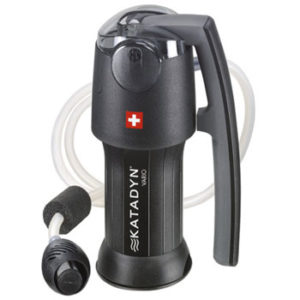 We start off this list with the Katadyn Vario water filter. This unit is small enough to fit comfortably in a backpack and doesn’t weigh too much. Thanks to its efficient filtering mediums, this model is capable of filtering up to 2 quarts of water per minute.
We start off this list with the Katadyn Vario water filter. This unit is small enough to fit comfortably in a backpack and doesn’t weigh too much. Thanks to its efficient filtering mediums, this model is capable of filtering up to 2 quarts of water per minute.
One of the things we liked about this model is that it has a well-thought design. This model comes with an outlet and an inlet hose that measure 36” each, and a plastic clip that will attach the hose to your water bottle, preventing it from falling as the bottle fills.
The filter’s pump works fast, and you don’t have to put a lot of effort into pumping water.
The charcoal filters remove most of the unpleasant tastes and smells, making the water drinkable and good tasting.
- Pros:
Good Instructions – This model comes with clear instructions that are easy to follow - Cons:
Pump Can Stop – The piston and valve assemblies do a great job at pumping the water fast, but they can get air-locked at times.
5. Sawyer Products PointOne Squeeze Water Filter
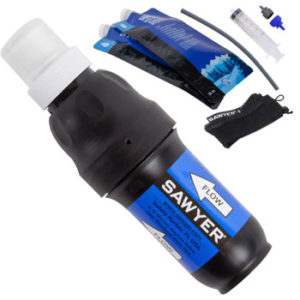 The Sawyer PointOne is a complete water filtration system suitable for those who are passionate about hiking, camping, and traveling, but it can also be a valuable asset for those who want to be prepared in an emergency situation. This model can remove more than 99.9% of the bacteria and protozoa that live in the water, so it will allow you to drink from any source of freshwater you discover.
The Sawyer PointOne is a complete water filtration system suitable for those who are passionate about hiking, camping, and traveling, but it can also be a valuable asset for those who want to be prepared in an emergency situation. This model can remove more than 99.9% of the bacteria and protozoa that live in the water, so it will allow you to drink from any source of freshwater you discover.
One of the things we liked about this model is that it comes with an ingenious adapter. You can connect the adapter to the 32-ounce pouch and use it to transfer the filtered water from the pouch to your drinking bottle, or you can use it to connect it to a faucet or a bucket and filter the water in an emergency situation.
- Pros:
Long-Lasting – You can use the water filter for a very long time. This model can filter up to 1 million gallons without needing a replacement filter cartridge. - Cons:
Pouches Could Be Better – The water pouches are vulnerable near their necks, and they can sometimes burst
6. LifeStraw Go Water Filter Bottle
 The LifeStraw Go water filter bottle is a great model for those who enjoy backpacking, camping, and traveling, but it can also be a good addition to your emergency kit. This water filter uses a 2-stage activated carbon filter cartridge to remove any foul tastes and smells, and it uses a hollow fiber membrane to remove 99.99% of the bacteria and protozoa in the water.
The LifeStraw Go water filter bottle is a great model for those who enjoy backpacking, camping, and traveling, but it can also be a good addition to your emergency kit. This water filter uses a 2-stage activated carbon filter cartridge to remove any foul tastes and smells, and it uses a hollow fiber membrane to remove 99.99% of the bacteria and protozoa in the water.
We liked this water filter’s design. The water bottle is made out of BPA-free plastic, and the mouthpiece is made out of soft silicone, making it very comfortable to use. You can remove the mouthpiece and use the plastic container like a normal water bottle when you’re confident the water is safe to use, and you can attach the mouthpiece and filter the dirty water when you have to. A single straw filter can clean up to 264 gallons of water. When the filter reaches its limit, it will stop taking in water.
- Pros:
Easy To Use – This portable water filter is really easy to assemble and use. - Cons:
Poor Quality Control – Some customers complained that their water bottles leaked. If this happens to you, contact the manufacturer for a replacement.
7. Survivor Filter PRO
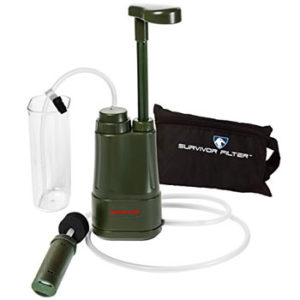 The Survivor Filter Pro is a small and compact water filter that can remove most of the contaminants in the water. This model is very efficient, and it will remove 99.9% of the bacteria and viruses in the water, and up to 99.5% of the heavy metals that frequently contaminate water. The filter will also remove protozoa and parasites.
The Survivor Filter Pro is a small and compact water filter that can remove most of the contaminants in the water. This model is very efficient, and it will remove 99.9% of the bacteria and viruses in the water, and up to 99.5% of the heavy metals that frequently contaminate water. The filter will also remove protozoa and parasites.
We were impressed by how fast this small water pump manages to filter the water. The filter can produce up to 17 ounces of fresh water every minute, and it comes with all the necessary accessories to make the filtering process easy and straightforward. A single bacteria filter cartridge can clean up to 100,000 liters of contaminated water, so it’s safe to say you can use this water filter for a long time.
- Pros:
Good Flow Rate – This model can produce up to 17 ounces of clean water per minute. - Cons:
Dirty Lines Can Contaminate The Clean Ones – There is no way to separate the dirty lines from the clean ones, so the first can contaminate the latter.
8. LifeStraw Family 1.0 Water Purifier
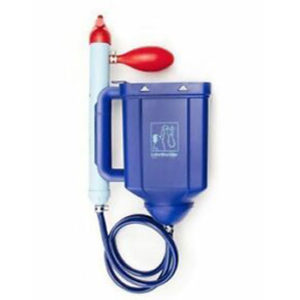 The LifeStraw Family water purifier is a great filtering solution for those who like to like to spend their time in nature, and it’s also a helpful tool in your emergency situation kit.
The LifeStraw Family water purifier is a great filtering solution for those who like to like to spend their time in nature, and it’s also a helpful tool in your emergency situation kit.
This model uses a gravity filter. You simply pour the water into the unit’s top and it comes out filtered out of its bottom.
As far as the filter’s efficiency is concerned, this model will remove up to 99.99% of the bacteria, viruses, protozoa, and parasites that live in the water. The filter also works quickly, and it’s capable of purifying up to 12 liters (3.17 gallons) of water per hour.
We were impressed by the filter’s large capacity. With a filtering rate of up to 3 gallons per hour, this model cleans enough water for a small family or a group of friends who camp or travel together.
- Pros:
Good Filtering Capacity – This model can clean a lot of water in a short amount of time, making it suitable for small to medium groups - Cons:
Missing Parts – Many customers complained that their packages didn’t contain all the accessories they should. If this happens, contact the manufacturer’s customer support service for replacements.
Buying Guide: How to Buy a Portable Water Filter
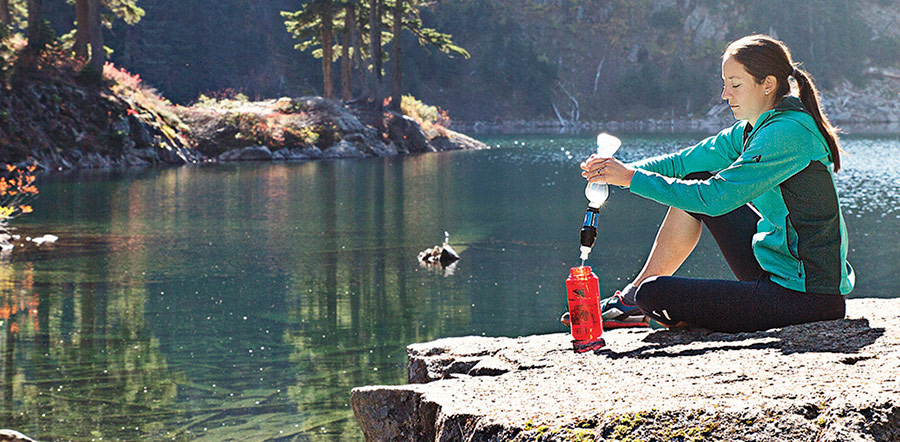
Drinking clean water should be one of your priorities, no matter your location. Whether you’re camping in the mountains or traveling in foreign countries, you should always make sure that the water you drink is clean and healthy. Portable water filters offer an easy solution to this problem. These models are small enough to fit in a backpack, and they’re efficient enough to clean every source of water.
But finding the right portable water filter can seem like a daunting task at times. There are a lot of models available on the market, and it’s difficult to tell which can perform better than the other. In the following section, we explain how to choose a water filter, how a water filter works, and why you should use such a filter when you’re traveling.
Types of Portable Water Filters
 As you could see in our short reviews, there is more than one type of portable water filter. Even though they lead to similar results, each type filters the water in its own way. Let’s take a look at how they do it and the pros and cons of using each type of filter.
As you could see in our short reviews, there is more than one type of portable water filter. Even though they lead to similar results, each type filters the water in its own way. Let’s take a look at how they do it and the pros and cons of using each type of filter.
Straw Filters
Straw water filters are the lightest portable filtration solution available now. Just like the name suggests, these filters usually look like overly large straws, and they work like straws as well. To use these filters, you just have to get close to the water source and draw in water through the straw.
Unlike a regular straw, the filter requires a more powerful draw in order to work, but the filtration process is really easy and straightforward. Straw filters use cartridges made out of the hollow fiber membrane. These fibers are tightly woven together, so the water has to pass through a lot of fiber layers before reaching the actual straw you’re drawing on. The fibers are also very porous, but the holes in the fibers are very small.
Most membranes use holes that are 0.2 microns wide, so that’s one hundred thousand smaller a 2 cm hole. The water passes through the holes in its way to the straw, but all the bacteria, viruses, and parasites in the water are larger than the hole, and they will be trapped and won’t be able to pass.
Basically, all the elements that float in the water are too large to pass, so the water you end up drinking contains no residue or bacteria
Pros:
- Efficiently removes all sediment and debris
- Removes the particles that cause the water to taste and smell bad
- Efficiently removes bacteria, viruses, protozoa, parasites
Cons:
- The holes in the membrane get clogged with debris, sediment, and bacteria over time, so you have to change them.
- Not very efficient at removing dissolved contaminants like chlorine, heavy metals, and pharmaceuticals
Pump Filters
Pump filters are not extremely small, but they’re still small enough to fit in a backpack without taking up too much space. To use the filters, you have to connect a lead line to the water source and another line to a water recipient. You use a small hand pump to draw the water.
Now, some pump filters rely on ceramic filters, some use fiber filters, and some use one of these filtration techniques in conjunction with an activated carbon filter or even a block activated carbon. The fiber filters work exactly as the straw filters’ hollow membrane filters and mechanically stop the contaminants from reaching your drinking water. The ceramic filters also provide mechanical filtration. These filters are also porous, and their surfaces are usually covered in 0.5 – 1-micron holes. The water passes through the small holes, but all the contaminants are blocked. One of the advantages of using ceramic filters is that they can stop the asbestos that might contaminate your water.
However, a disadvantage is that some bacteria are small enough to pass through the ceramic filter and end up in your water. Another disadvantage is that the ceramic filter doesn’t stop organic compounds from contaminating the water. That’s why some manufacturers use it in conjunction with an activated carbon filter. The activated carbon has millions of extremely small pores between its carbon atoms. Each gram of activated carbon presents a surface area of up to 2,000 square meters, and the contaminants in the water will be trapped on this surface. Here are the pros and cons of using an activated carbon filter.
Pros:
- Improves the water’s smell and taste
- Usually, an activated carbon filter has to be changed only once a year
- The beneficial minerals in the water are not eliminated by this filter
Cons:
- The filter itself may become a breeding ground for the trapped bacteria if it’s not changed when it’s supposed to
- The pores in the carbon granules are large, and they won’t stop some bacteria species
Bottle Filters
 Bottle filters have the advantage of being useful even when you don’t have to filter your drinking water. You can simply remove the bottle’s filter cartridge and use it as a normal drinking bottle when you’re certain your water source is safe and healthy.
Bottle filters have the advantage of being useful even when you don’t have to filter your drinking water. You can simply remove the bottle’s filter cartridge and use it as a normal drinking bottle when you’re certain your water source is safe and healthy.When you have to drink from a water source that’s most likely contaminated, you can simply put it in the filter cartridge and use the bottle as a filter. Most bottle filters rely on fiber filters to clean the water, but some models use solid block activated carbon filters instead.
The models that use fiber filters work just like the straw filters we described earlier, but instead of dipping the straw in a water source, you’re actually using the bottle as a recipient for the contaminated water. The straw will filter out the contaminants and allow only clean water to reach the mouthpiece. Now, the models that use an activated carbon block filter to clean the water use a similar technology to the one we described earlier, only better.
In this case, the activated carbon has been treated and compressed to create a uniform matrix. This will allow the activated carbon to absorb more chemicals and reduce the size of their pores, making them more efficient at trapping bacteria and parasites.
Pros:
- Effectively reduce the heavy metals, arsenic, and other dangerous contaminants in the water.
- Effectively blocks the bacteria and viruses from reaching your drinking water
- Allows the beneficial minerals to remain in the water
Cons:
- Dissolved salts like fluoride and nitrates are not reduced
- Does not reduce cadmium
Gravity Filters
 Gravity water filters are great for campers, trekkers, and emergency preppers because they don’t need electricity or a constant water supply to work. These models are perfect for those who like to travel in remote areas where clean water is not readily available. These water filters are usually made out of two containers placed above each other.
Gravity water filters are great for campers, trekkers, and emergency preppers because they don’t need electricity or a constant water supply to work. These models are perfect for those who like to travel in remote areas where clean water is not readily available. These water filters are usually made out of two containers placed above each other.To use this filter, you pour water into the first container. Thanks to the gravity pull, the water passes through some filter mediums and ends up in the other container which is placed lower. The second container features a tap you can use to refill your water recipient.
Gravity filtration usually relies on a combination of ceramic and activated carbon filters to clean the water. Thanks to the conjoined action of these filter mediums, the water produced is very clean and free of harmful contaminants.
Pros:
- Efficiently removes bacteria, viruses, protozoa, and parasites from the water
- Can remove some herbicides, pesticides, and other man-made contaminants that may affect the water
- Can filter out chlorine from the water
- The filter cartridges can last for up to one year of use
Cons:
- Larger than other types of water filters
- Is made out of multiple parts
- The first container can contaminate the second if it’s not stored properly
UV Filters
Even though campers or hikers do not very frequently use them, there are some good UV portable water filters out there. These models run on batteries so that they will have higher operating costs. One of the advantages of using UV filters is that they’re very effective against bacteria and parasites.
Pros:
- Improve the water’s smell and taste
- Works quickly
- Beneficial minerals are not removed from the water
- Effective against bacteria, viruses, protozoa, and parasites
Cons:
- Battery operated
- Their effectiveness decreases as the water is dirtier. The sediment and debris in the water can negatively influence the filter’s effect
- Does not affect heavy metals or chemicals like chlorine
Why You Need a Backpacking Water Filter
Whether you’re a wilderness or an urban explorer, having access to clean and healthy water should be your utmost priority. Few things can be as harmful as contaminated water. Sure, you might eat something bad, but while you can easily quench your hunger, you can barely function without water.
And unfortunately, there are a lot of harmful elements that you can find in untreated or poorly treated water. Here is a list of some of the most frequent water contaminants
- E. coli – E. coli infections cause fever, vomiting, abdominal pain, and diarrhea. The symptoms might appear right away, or they might appear within a week of the contamination
- Giardia Lamblia – You probably heard of giardiasis by now. Giardiasis causes nausea, stomach cramps, and diarrhea. The symptoms usually appear within two weeks of the contamination
- Salmonella – Salmonella infection leads to fever, diarrhea, nausea, muscle cramps. The symptoms can appear within 3 days of the contamination
- Hepatitis A – Hepatitis A is caused by a virus that can be found in water. The infection can lead to nausea, stomach pain, fever, and jaundice. The symptoms usually appear within 28 days of the contamination
- Legionella pneumonia – This bacteria causes the infection known as Legionnaires’ disease. The infection leads to fever, muscle aches, cough, and it may result in death if untreated.
Top 5 Things to Consider When Buying a Portable Water Filter
There are a lot of things you should take into consideration when you’re shopping for a portable water filter or a water purifier. Here’s what you should look for
Weight
There’s no point in buying a portable water filter if it’s uncomfortable to carry around when you travel. You should always take the filter’s weight into consideration before deciding on a model. Most portable water filters are small and compact, but their weight can vary according to their design, filtering technology used, and construction materials.
Filtration Speed
Every portable water filter will remove the contaminants from the water at a specific rate. Some of them will produce a couple of ounces of clean water every minute, while others can produce nearly 20 ounces of water in the same timeframe. Using a unit that’s capable of filtering the water quickly can be an advantage if you plan on traveling or camping with a large group of people.
Filter Capacity
Like it or not, every filter cartridge has a limited lifespan. Some models might last for a few days, while others can be used with good results for a few weeks or even months. However, the highest quality portable filters use long-lasting filter cartridges. Some models will allow you to filter up to 264 gallons of water with a single cartridge, while others will clean up to 100,000 gallons of contaminated water.
Ease of Use
Despite the fact that they are small and compact, not all portable water filters are easy to use. Some models come with detailed installation and priming instructions, and you might have to take the instructions with you when you travel to make sure you set them up properly. Other models are extremely simple to use, and you simply have to draw water through them and drink it, as if you were using a straw. Furthermore, the maintenance of the water filter should be easy, too.
Cost
The best approach to finding a water filter that matches your budget is to set a budget before you start browsing for one. Just like all the other products you can buy, potable water filters come at different prices, and buying the most expensive model doesn’t guarantee you’re getting the best model. Plenty of efficient models come at low prices so that you can get a small and functional unit at a great price.
Water Filters VS. Water Purifiers
Despite the fact that most people use water filters and water purifiers as interchangeable terms, they do not actually mean the same thing. Here’s a short definition of how water filtration and water purification are different.
Water Filters
Water filters are more popular than purifiers, and that’s because they’re more often than not more useful. These filters help remove or reduce the impurities you can find in the water.
The impurities they can clean or reduce include but are not limited to iron, nickel, lead, mercury, chlorine, chromium, copper, and more. Although they don’t eliminate all the bacteria and viruses from the water, water filters can effectively reduce their number, and they can eliminate certain species of bacteria altogether. You can check out our article to learn how to clean your water filters.
Water Purifiers
As a rule of thumb, the term water purifiers refers to the units that can remove all the bacterial, viral, and parasitical contaminants in the water. These models will do a great job of removing any bacteria, viruses, protozoa, and parasites in your drinking water, but they won’t remove any other contaminants. This is why water purifiers are more difficult to find.
Most manufacturers prefer to develop purifiers that work in conjuncture with a water filter, so the models they develop will be able to remove both the bacteria and the sediment and chemicals that might contaminate the water.
Water Treatment For Camping & Hiking
 As you can see, there are many types of water filters, but are all of them efficient in every possible scenario? Let’s take a look at some of the best backpacking water filters in regards to backpacker types.
As you can see, there are many types of water filters, but are all of them efficient in every possible scenario? Let’s take a look at some of the best backpacking water filters in regards to backpacker types.
Wilderness Backpacker
If you’re one of the people who enjoy spending a lot of time in the wilderness, you probably know by not that you need a water filtering solution if you’re planning on spending a lot of time outdoors. There are ways of purifying water in the outdoors. Sure, boiling the water is also a form of treatment, but water boiling is by far not the most effective treatment solution. Pump water filters are great for wilderness backpackers because they can filter a large quantity of water in a short time, giving you the possibility to pack your daily ration of water in a matter of minutes. Plus, you can consider using water purification tablets in times of an emergency.
Ultralight Backpacker
If you enjoy trekking and hiking, but you don’t like carrying a large backpack when you’re exploring the sights, you should use a straw or a bottle filter. These models are so small they will fit in every backpack. In fact, both of these filter types will most likely fit in a pocket, or you can simply carry them in your hands.
Car Camper
People who enjoy camping in their cars usually do so accompanied by friends and family. This is why they more often than not need a water filter that’s capable of cleaning a large quantity of water. The perfect models for car campers are either gravity water filters or pump filters. Both these models have a good output, and they can quench the thirst of multiple people each day
Day Hiker
Day hikers usually travel light. Some might not even carry a backpack at all, and if they do, the backpack is usually small and compact. This is why the best models for day hikers are straw or the best filtered water bottles.
Urban Hiker
If you’re an urban hunter, you might end up in some parts of the world that don’t offer easy access to clean and healthy water. If this is the case, you must take the matter into your own hands and purify the water as you go. The right portable water filter choices for urban hikers are pump filters for those who travel in groups and straw or bottle filters for those who travel alone.
You can also make a DIY water filter for half the price of other water filters.
Wrap Up
As you could see in our portable water filter reviews and comprehensive buying guide, finding the right one is not very difficult once you know what to look for. These modes can be installed and primed with ease, and they will transform almost all sources of fresh water into clean potable water.
The first thing you should do when looking for the best backpacking water filter is to think of how you’re more likely to use it. If you’re an urban explorer, you might be better off buying a small model.
But if you’re looking for a camping water filter, it would be better to choose a model that offers a better filtering rate.
Check out our homepage for more product reviews including refrigerator water filter reviews and the best submersible well pumps.

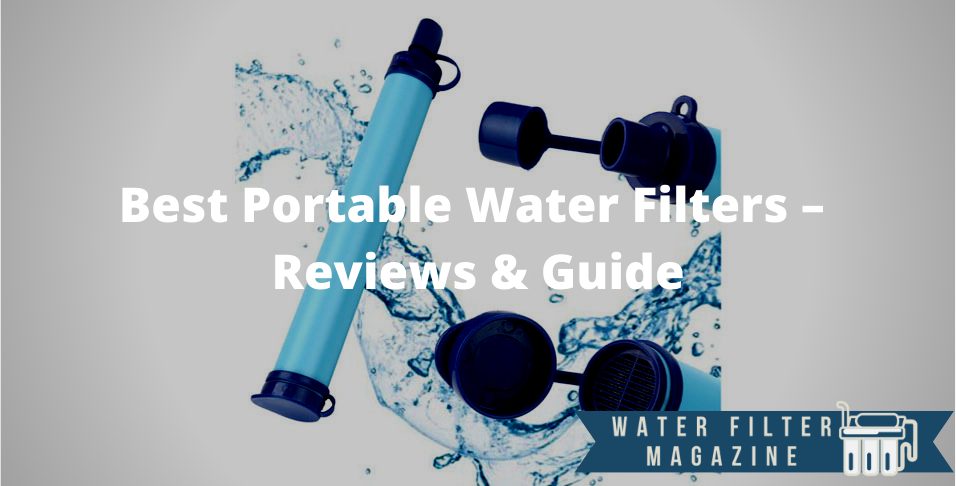
 Bottle filters have the advantage of being useful even when you don’t have to filter your drinking water. You can simply remove the bottle’s filter cartridge and use it as a normal drinking bottle when you’re certain your water source is safe and healthy.
Bottle filters have the advantage of being useful even when you don’t have to filter your drinking water. You can simply remove the bottle’s filter cartridge and use it as a normal drinking bottle when you’re certain your water source is safe and healthy.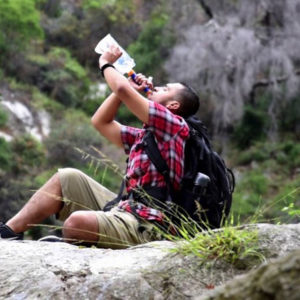 Gravity water filters are great for campers, trekkers, and emergency preppers because they don’t need electricity or a constant water supply to work. These models are perfect for those who like to travel in remote areas where clean water is not readily available. These water filters are usually made out of two containers placed above each other.
Gravity water filters are great for campers, trekkers, and emergency preppers because they don’t need electricity or a constant water supply to work. These models are perfect for those who like to travel in remote areas where clean water is not readily available. These water filters are usually made out of two containers placed above each other.